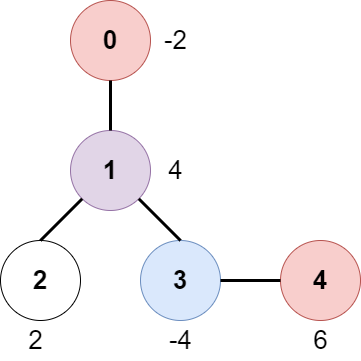Problem
There is an undirected tree with n nodes labeled from 0 to n - 1, rooted at node 0. You are given a 2D integer array edges of length n - 1 where edges[i] = [aᵢ, bᵢ] indicates that there is an edge between nodes aᵢ and bᵢ in the tree.
At every node i, there is a gate. You are also given an array of even integers amount, where amount[i] represents:
- the price needed to open the gate at node
i, ifamount[i]is negative, or, - the cash reward obtained on opening the gate at node
i, otherwise.
The game goes on as follows:
- Initially, Alice is at node
0and Bob is at nodebob. - At every second, Alice and Bob each move to an adjacent node. Alice moves towards some leaf node, while Bob moves towards node
0. - For every node along their path, Alice and Bob either spend money to open the gate at that node, or accept the reward. Note that:
- If the gate is already open, no price will be required, nor will there be any cash reward.
- If Alice and Bob reach the node simultaneously, they share the price/reward for opening the gate there. In other words, if the price to open the gate is
c, then both Alice and Bob payc / 2each. Similarly, if the reward at the gate isc, both of them receivec / 2each.
- If Alice reaches a leaf node, she stops moving. Similarly, if Bob reaches node
0, he stops moving. Note that these events are independent of each other.
Return the maximum net income Alice can have if she travels towards the optimal leaf node.
https://leetcode.com/problems/most-profitable-path-in-a-tree/
Example 1:

Input:
edges = [[0,1],[1,2],[1,3],[3,4]], bob = 3, amount = [-2,4,2,-4,6]
Output:6
Explanation:
The above diagram represents the given tree. The game goes as follows:
Alice is initially on node 0, Bob on node 3. They open the gates of their respective nodes.
Alice’s net income is now -2.Both Alice and Bob move to node 1.
Since they reach here simultaneously, they open the gate together and share the reward.
Alice’s net income becomes-2 + (4 / 2) = 0.Alice moves on to node 3. Since Bob already opened its gate, Alice’s income remains unchanged.
Bob moves on to node 0, and stops moving.Alice moves on to node 4 and opens the gate there. Her net income becomes
0 + 6 = 6.
Now, neither Alice nor Bob can make any further moves, and the game ends.It is not possible for Alice to get a higher net income.
Example 2:

Input:
edges = [[0,1]], bob = 1, amount = [-7280,2350]
Output:-7280
Explanation:
Alice follows the path0->1whereas Bob follows the path1->0.
Thus, Alice opens the gate at node 0 only. Hence, her net income is -7280.
Constraints:
2 <= n <= 10⁵edges.length == n - 1edges[i].length == 20 <= aᵢ, bᵢ < naᵢ != bᵢedgesrepresents a valid tree.1 <= bob < namount.length == namount[i]is an even integer in the range[-10⁴, 10⁴].
Test Cases
1 | class Solution: |
1 | import pytest |
Thoughts
可以先把 Bob 对 amount 的影响确定下来。从根节点 0 到 bob 所在节点的路径可以求出来,设这条路径一共有 h 个节点,下边 ⌊h/2⌋ 个节点的门一定会被 Bob 开启,可以将这些节点的 profit 改为 0;上边 ⌊h/2⌋ 个节点,如果 Alice 经过则对应的 profit 全部归 Alice,而如果 Alice 不经过,则是否被 Bob 拿走也毫无影响。如果 h 是奇数,那么正中的节点,如果 Alice 经过则一定会跟 Bob 同时经过,profit(绝对值)减半。
直接 in-place 更新好 amount,之后就不用再关注 Bob 了。
对于 Alice,定义 dp(u) 表示在以 u 为根节点的子树,Alice 可以得到的最大 profit。题目所求即为 dp(0)。
易知状态转移公式为:
用后序遍历(post-order),先计算所有子节点的 dp 值,再计算当前节点。
Code
1 | class Solution: |